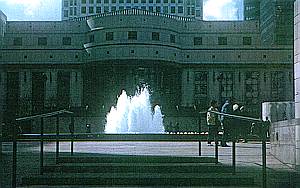 Figure 4. Closed Circuit Fountain by Dick Choix in Talbot Square. Canary Wharf. Docklands Most modern fountains, be they cascade or rising jet, use this system which grew up with the use of powered pumps. Pumps allow fountains to play where previously they could not. (figure 4.) This has brought pleasure to millions, although, man's artifice has its drawbacks as the water is invariably not drinkable. To the purists eye there is something contrived about the powered closed circuit fountain. This is probably because nature is uninvolved in the supply of water. The difference lies in the fact that the re circulatory fountains fail to fulfil the primary function that interlocked man and fountain from the beginning, in that they do not provide drinking water. The closed circuit becomes a metaphor of the fountain of Life and not a real one. The grand and generous fountains of Rome or the Vale of Kashmir flow day and night seen and unseen always with clean fresh water in a way that Witley Court or Trafalgar Square never can. It is necessary to move conceptually from a classical tuning of nature to a modern mastery of it to appreciate the closed circuit fountain. This effect may be and often is offset by careful settings to give the impression that the feature is in fact a result of nature's bounty. A small stream, for example, can have its source disguised to give that effect. Modern designers use closed circuit fountains which play in shopping malls, plazas, office buildings and gardens, copying an effect that nature rarely gives outside mountains or hills. With the new technology comes a new set of problems. Generally closed circuit fountains have much higher filtration and maintenance requirements than open system fountains. Because water attracts dust and air borne pollutants it very quickly becomes unattractive to the nose and eye unless it is purified. Also nature and the public habitually throw their debris in the pools, and if fish, plants or livestock use the pool they too add debris and pollutants to the water. Usually swimming pool type technology is used quite satisfactorily to clear the water, but the pools of fountains do not usually have the steep sided profile that many swimming pools do and thus the debris is not as conveniently collected. Where there is public access to the water there is usually a combination of skimmer technology and also water vacuum cleaning facilities which are built into the filtering scheme. Water evaporates and spills so there are automatic top up systems to stop the water level in the pools and basins dropping. In addition to this it is necessary to incorporate drainage facilities and backwash systems for the filters as the pools and filters will require regular maintenance. The water may also be chemically treated for hardness in order to stop any unsightly deposits forming on the display. Thus considerable space and expense goes towards making an effective closed circuit fountain. Factors in the design are discussed at the end of this work. NEXT: PURPOSES OF FOUNTAINS
|

http://www.gardening-uk.com/waterlands/
email: b.hirst@mac.com